Well, after understanding the axioms of Anekāntavāda in short with the help of paintings, we will try to understand this wonderful philosophy from different perspectives. Until and unless we see the practical view of a philosophy in our daily lives, it can never prove its utility.
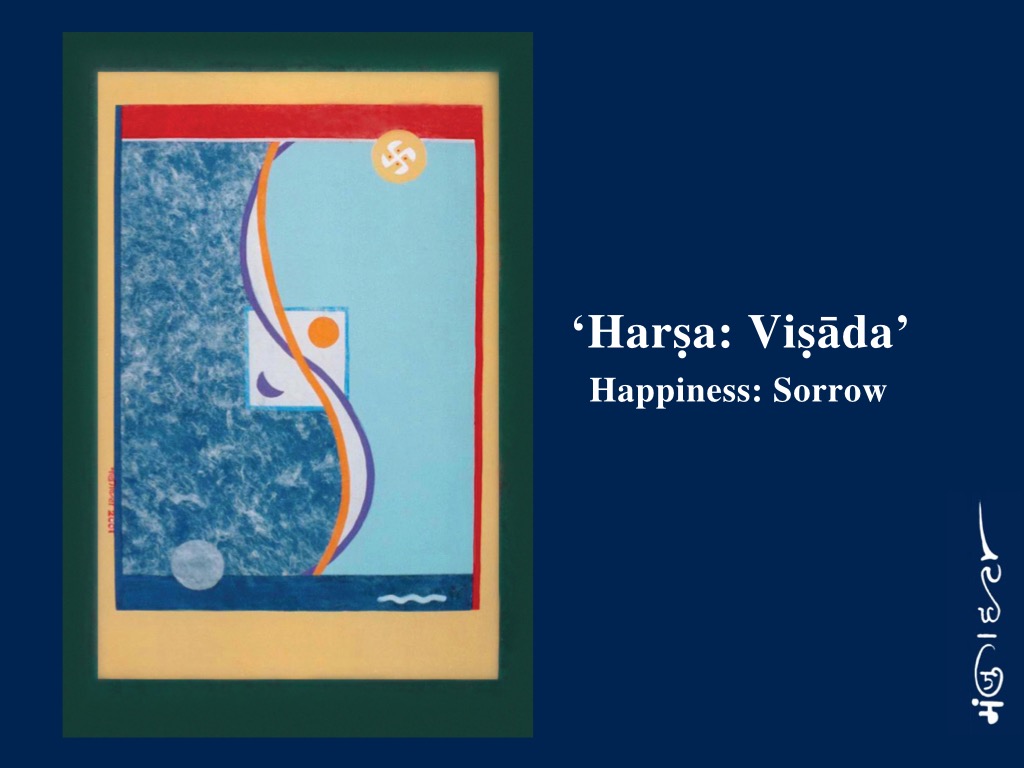
Happiness and sorrow are the two antonymous states of our mind. In this painting, the sky has been used as a backdrop to symbolise both the states: happiness and sorrow in human life. The sky, which is the base of the whole universe, can be seen in many forms, namely: day-night, dark-bright, clear-clouded and so forth. In the same fashion, in our 'life-sky' there is a continuous interplay of joy and sorrow, good and bad, dark side and bright side. On the right side of the painting is shown the clear, light-blue sky with a yellow sun and Svastika motif suggesting happiness; and on the left side is shown the dark night with scattered clouds covering the moonbeams and thus suggesting the sorrowful side of our life.
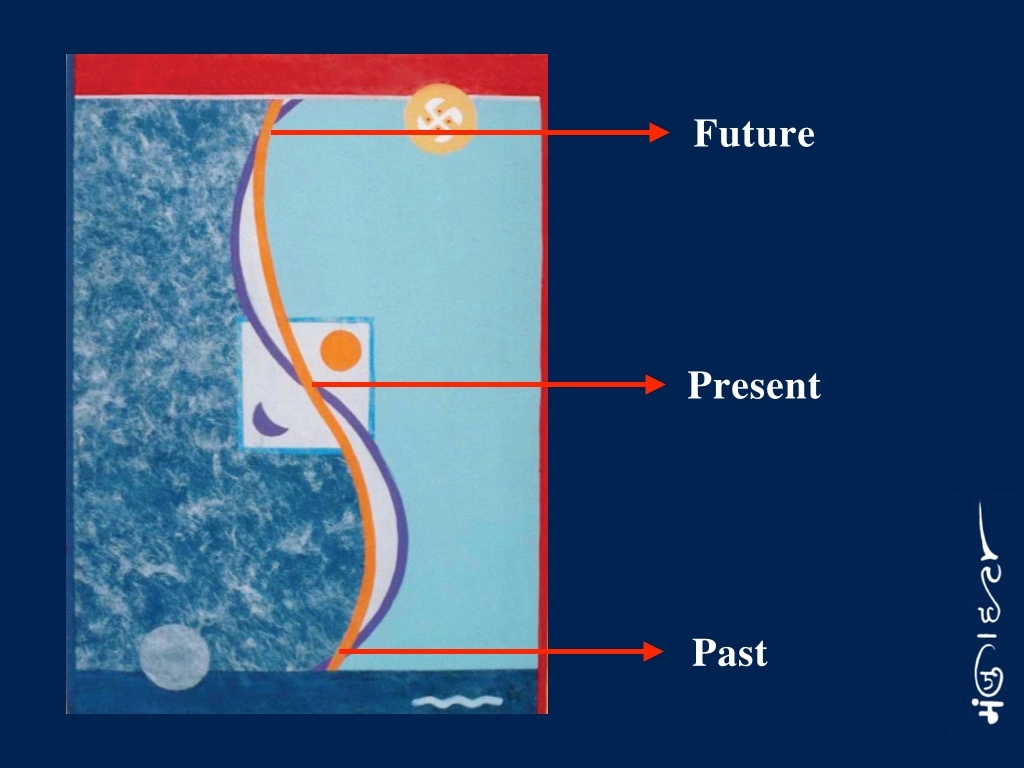
In the centre of the painting there is a white square symbolising life, in which, again, the sun, drawn in orange, resembles happiness and the violet crescent moon shows grief. The orange and violet lines respectively stand for happiness and sorrow cutting across the painting diagonally, intersecting each other at three points suggestive of trikāla. The twisting movement of the lines shows the coming and the disappearing of joy and sorrow in our life, like the sun and the cloud.
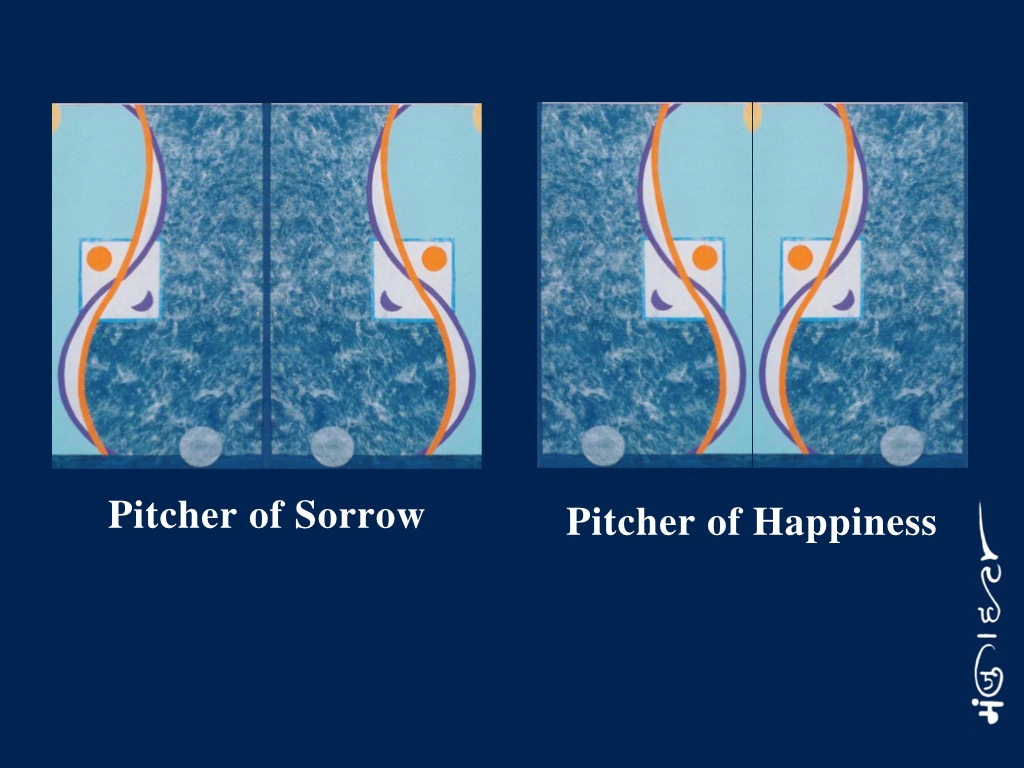
As we see this painting from a little distance, we can see the impression of two pitchers in their halves on both the sides. These are suggestive of the pitchers of wishes. On the left-hand side of the painting, the pitcher stands with its mouth open to suggest that we are always unsatisfied and in trouble. On the other hand, the right-hand side of the painting contains a pitcher turned upside down to suggest contentment and happiness leading to a life of joy; and the ripples below the right-hand side pitcher show the emptying of whatever residual desires it might have had. In fact, there is no distance between happiness and sorrow, both of them stay together.
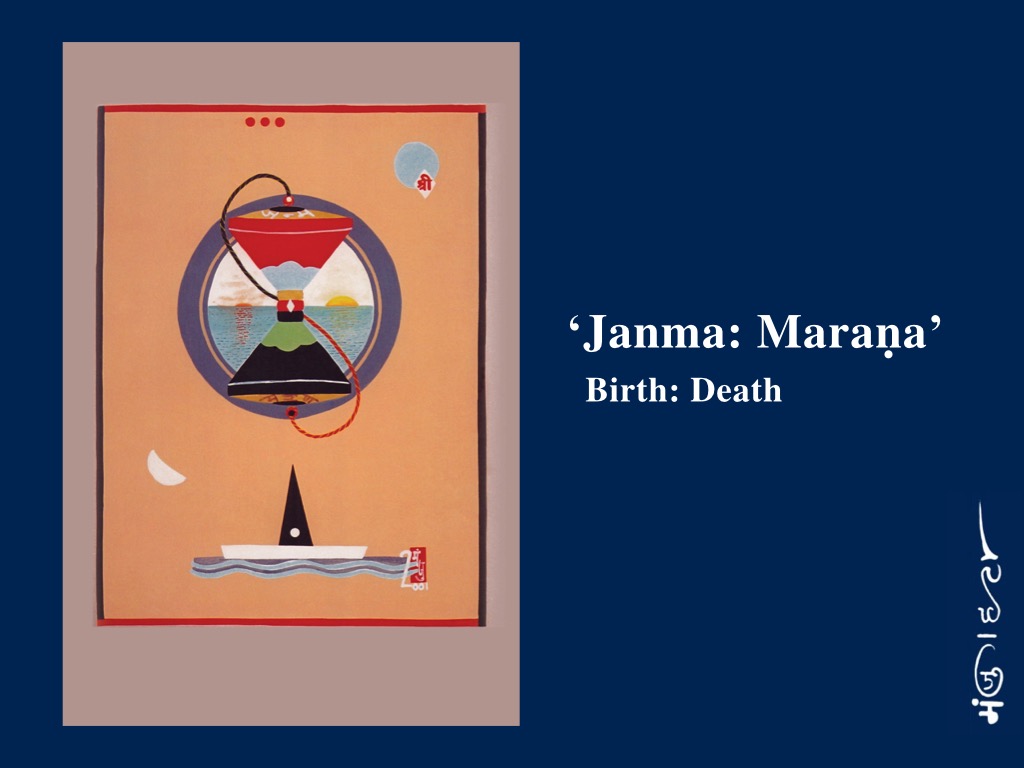

This painting presents the eternal cycle of Janma and Maraṇa (Birth and Death) of all worldly beings through the symbol of a damaru, a musical instrument having playing surfaces at both ends. Its narrow middle part can be held by the hand as it has been shown in the centre of the painting.
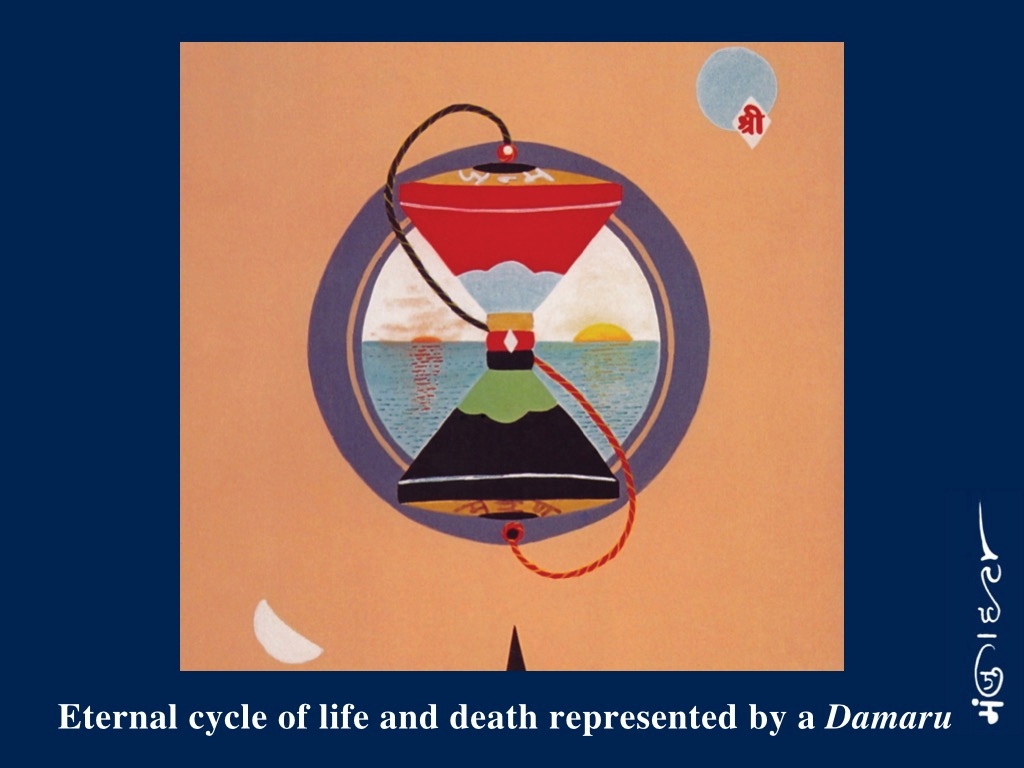
The upper part of the damaru, in red colour, shows life, whereas its nether part, in black colour, represents death. The light blue colour in the red-coloured portion of damaru stands for the sky and the light green in the black portion stands for the earth. The middle part of the damaru is painted in three colours, this trio represents the three phases of time - the Future is depicted in golden colour, the Present in red, and the Past in black. There is a small white Śrī-Vatsa (diamond-shaped) symbol painted on the space shown in red colour (which depicts the Present). It shows that only the Present time is in our hands and we should always try to get the best out of it. In the painting the sunrise and the sunset on either side of the damaru stand for life and death symbolically. The life and death are contradictions yet they come together and move on together. The same second a man lives, he is dying and vice versa. The above mentioned damaru and the sunrise and the sunset have been drawn within a circular form, resembling a 'Zero'.
Again, two ends of a string shown in a slanted S-shape are painted in two different colours: black and red. The black string is shown as tying the upper part of the damaru in red and thus representing the fact that as soon as we take our birth the process of death starts. Likewise, the red string is shown as tying the nether part of the damaru (in black) to represent the fact that as soon as we die our birth process starts. Thus, the string as a whole can be explained as symbolising the eternality of the Janama: Maraṇa cycle. In the canonical literature, Samavāo, seventeen kinds of deaths have been mentioned. Among these, first is āvīcimaraṇa, according to which, death starts gradually from the very moment a living being takes birth. Thus life and death are cyclically interrelated. The sun in light blue colour and the moon in white colour respectively stand for time. Life and death are also related to time. A red-coloured Śrī appears on a white-coloured Śrī-Vatsa sign on the light-blue sun. The Śrī means 'roop' (form) and life and death are nothing but only a change of forms. These forms are related to the bodily origination and cessation. The three red dots that appear at the topmost part of the painting right below the red border stand for three forms of time - the Future, the Present and the Past.
At the place below the damaru we can see light blue-coloured waves which stand for the ocean of life and death that we can cross only by abstinence.
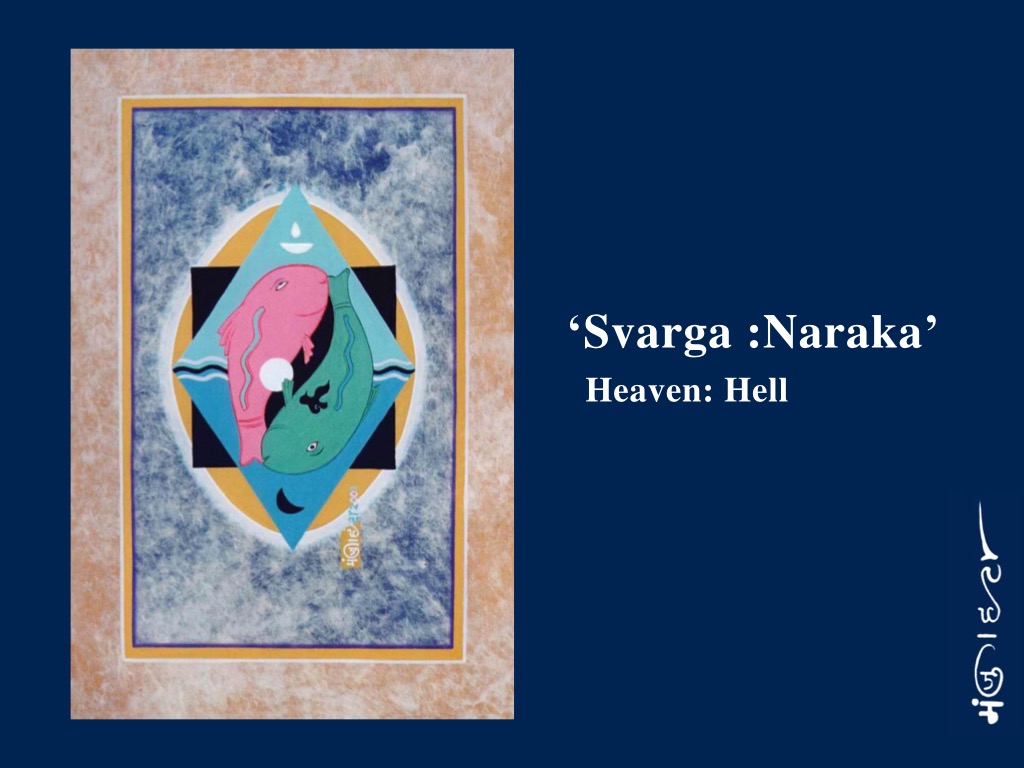
According to Jain philosophy, the world is eternal, as it has neither origin nor end. This philosophy also ascertains that it has no creator, neither protector, nor destroyer. All creatures, in accordance with their bondage of karmas, take their individual birth and die eventually.
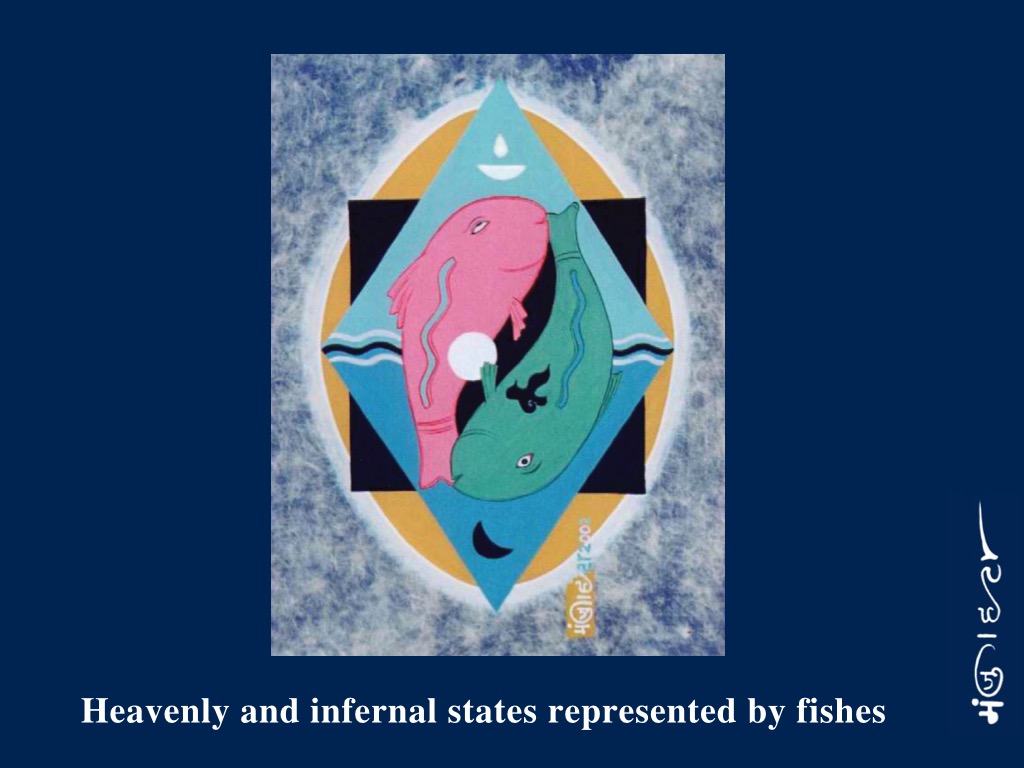
Here these two opposite states of a living creature - heavenly and infernal or say good and bad have been depicted symbolically through a pair of fish in the painting. We can see a beige-coloured, roundish-oval shape denoting the sphere. Next, there are two blue-coloured triangles, one shooting upwards and the other downwards respectively. The upper section of the triangle is in light blue and the nether section is in the dark blue. Seen as a whole, the two sections give an impression of a diamond shape, which symbolises Śrī-Vatsa.
In this above mentioned form, two fish have been shown; the one fish coloured in pink is in the upper triangle and the other painted in dull green, is in the nether triangle. We can see that the pink-fish looks happy and contented and this state of happiness and contentment is evident in its 'eye', whereas the other fish, down below, looks troubled and discontented and this state of trouble and discontentment is evident in its 'eye'. The two 'eyes', in fact, reflect two sharply contrasted experiences: contentment and discontentment, happiness and unhappiness and so on. The crescent moon, deliberately painted black, is redolent of macabre effect (fear of death), whereas that painted in white is suggestive of contentment. The white circle on the body of the pink fish suggests its state of supreme bliss, while the black flame on the body of the green fish suggests a state of tribulation. Thus, the painting tells us that, in the terms of the Jain philosophy it is the differences of the bondage of karma, that explains the state of happiness and unhappiness as experienced on earth by individuals. The two fish, we can say, highlight two aspects: Svarga: Naraka (Heaven /Hell).
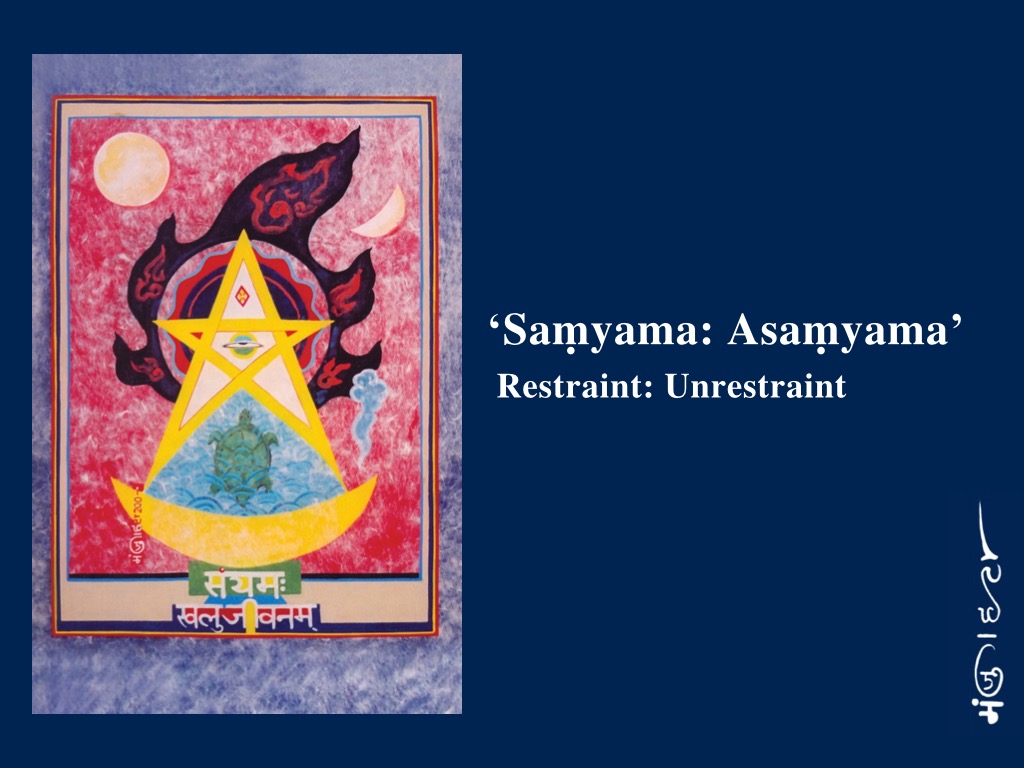
It is an accepted fact of life that no human being can deny the workings of the five senses. The question of 'restraint' and 'unrestraint' is related to our control over these five senses through the power of the mind. Knowledge of the world comes to us through the gates of the senses and happy is the man who can show restraint of his senses by application of his mental strength. This theme of 'restraint' and 'unrestraint' has been shown symbolically and imaginatively in my painting.
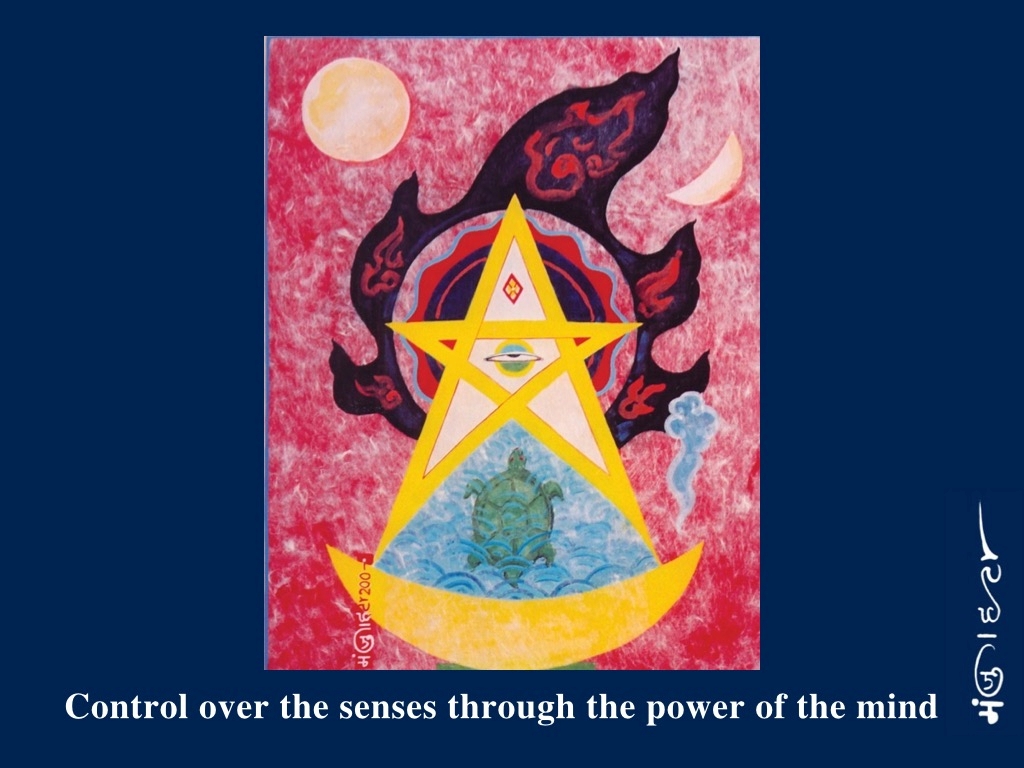
In this painting, the yellow star with five interlocked arms stands for five senses. Below it, there is a big yellow half-moon which stands for the mind. We get the knowledge of the external world through the avenues of the five senses (form, taste, smell, sight, and sound) but its assimilation and its expansion depends on our mind.
We can see five ugly black flames at the outer part of the yellow star, which show attachment, attraction and unrestrained desires. These flames show the sorrows and troubles created by attachment, attraction and unrestrained desires as they are fanned with the gales of passion. However, a question may arise as to why the flames have been painted in black? The answer is simply, that these are not natural flames but flames which are suggestive of five senses corrupted on account of an unrestrained mind.
In the painting, we can see a turtle painted in the blue water; and, symbolically, it is presented as an example of 'Abstinence'; for, a turtle withdraws himself into his shell at the time of attack and thus protects himself. Likewise, we should also protect ourselves from the worldly desires and greed as and when we are exposed to them through the five senses, collectively or singularly.
jahā kumme saaṅgāī, sae dehe samāhar. evam pāvāiṃ mehāvī, ajjhappeṇa samāhare
There is a red Śrī-Vatsa and an eye of the knowledge in the yellow-star, in the white background, which depict respectively the soul and the right knowledge. If we want to prevent ourselves from the allurement of the five senses (shown by the black flames of the unabstinence), it is necessary to have the right knowledge and the power to stay unperturbed internally. The sun and the moon signify 'time'. An ascending cloud indicated the state of upwardly rising abstemious mind. Below the yellow half-moon, a line has been quoted 'saṃyamaḥ khalu jīvanam' which contains the theme of the painting.
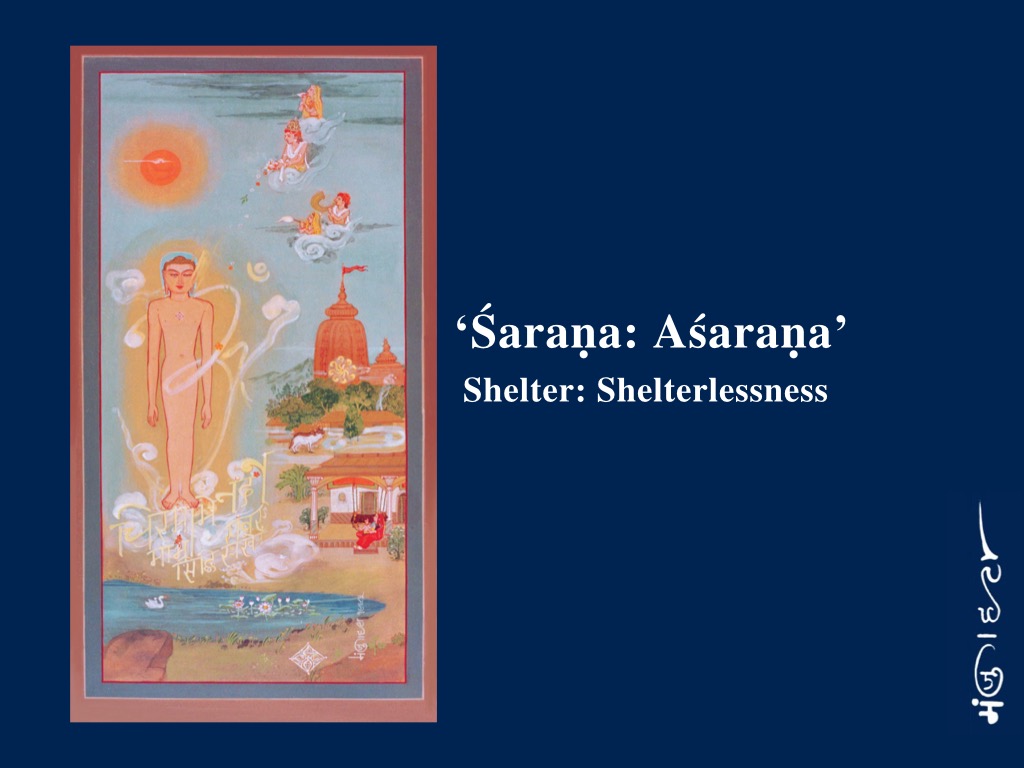
After Lord Abhinandan, the fourth tīrthaṅkara, attained enlightenment he gave his first sermon on the subject 'Śaraṇa: Aśaraṇa' (Shelter: Shelterlessness).
Mother and child, animal families as shown in the painting (such as duck and ducklings, cow and bull), are common worldly relationships. The relationship inheres the concept of 'Shelter' - a son comfortably sheltered in his mother's lap, for example. But the point is that it doesn't last forever, because all men and animals are mortal.
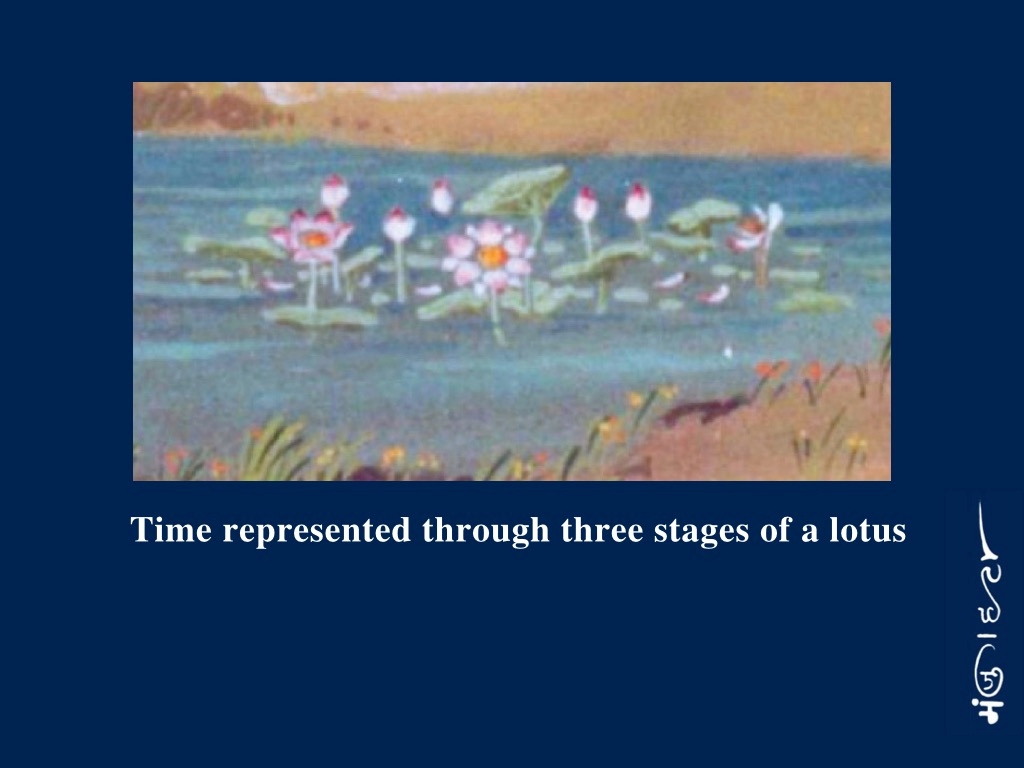
Likewise, wealth and family bondage are transitory. They cannot give protection or refuge except for a semblance for it. Time takes its unavoidable toll on all. Three stages of the lotus show the movement of Kāla or Time: the past (withered lotus), the present (bloomed lotus) and the future (the lotus-bud).
So it appears that what we in our worldly life call 'Shelter' is actually 'Shelterlessness'. It is far more important to seek shelter in Ātmadharma. Thus there is none else whose refuse we can seek, except that of our own self or Ātmā. That is what constitutes true shelter and which will lead to the knowledge to distinguish between 'Shelter: Shelterlessness'.
The colour scheme is so spread over the whole painting as to catch the very essence of what constitutes true shelter for us. The 'house' the 'stairs' on which mother and child are seated, the 'pond'- all these look diminutive to the magnificent figure of Lord Abhinandan. From the practical point of view others can protect one but from real point of view no body can protect any body.
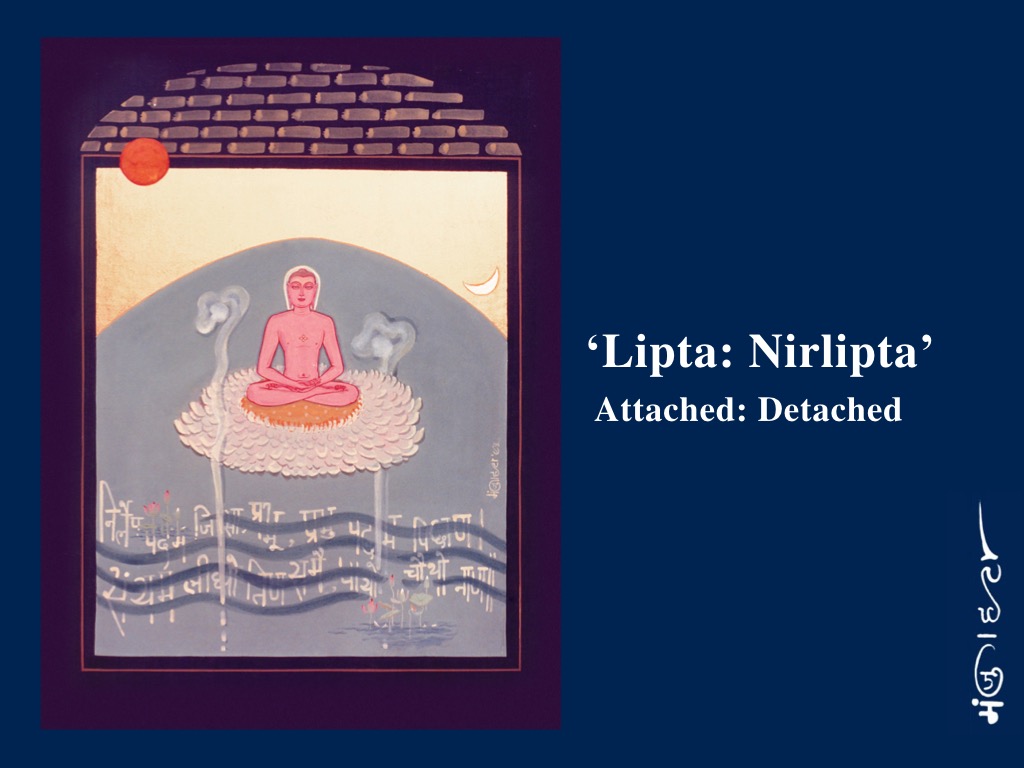
In this world, there are two kinds of human beings: those who are passionately attached to the worldly things and those who are completely withdrawn from these things. Arihantas are completely detached from the materialistic world and hence they come under the second category. In this painting, I have chosen Lord Padma, the sixth tīrthaṅkara, and have shown four specific points of resemblance drawn between Lord Padma and the lotus flower or 'Padma'. These points are: a similarity in the name, complexion, in the virtue as detachment, and the lotus itself that is a symbol of Lord Padma.
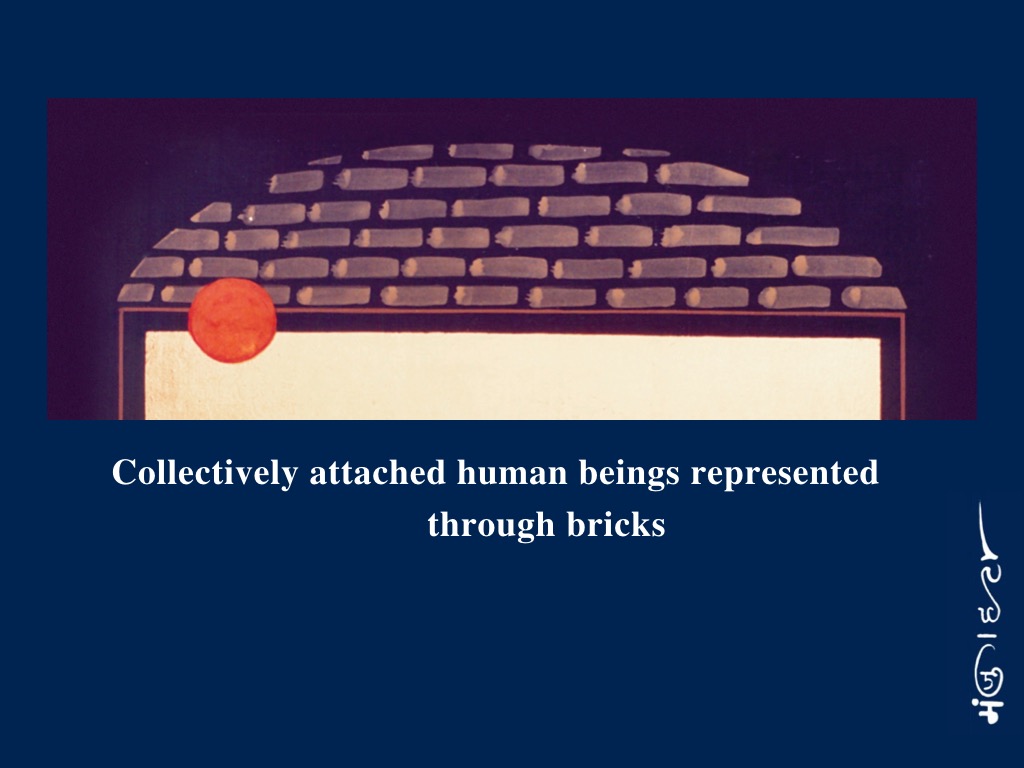
Here we can see an impression of the worldly abode, to which the first category of human beings are collectively attached, and suggested by layers of bricks. The background is in black. Those who are deeply attached to this world very often tend to forget that here they live but purely temporarily and this forgetfulness makes them elude the fact that the world should not be allowed to stay in their hearts.
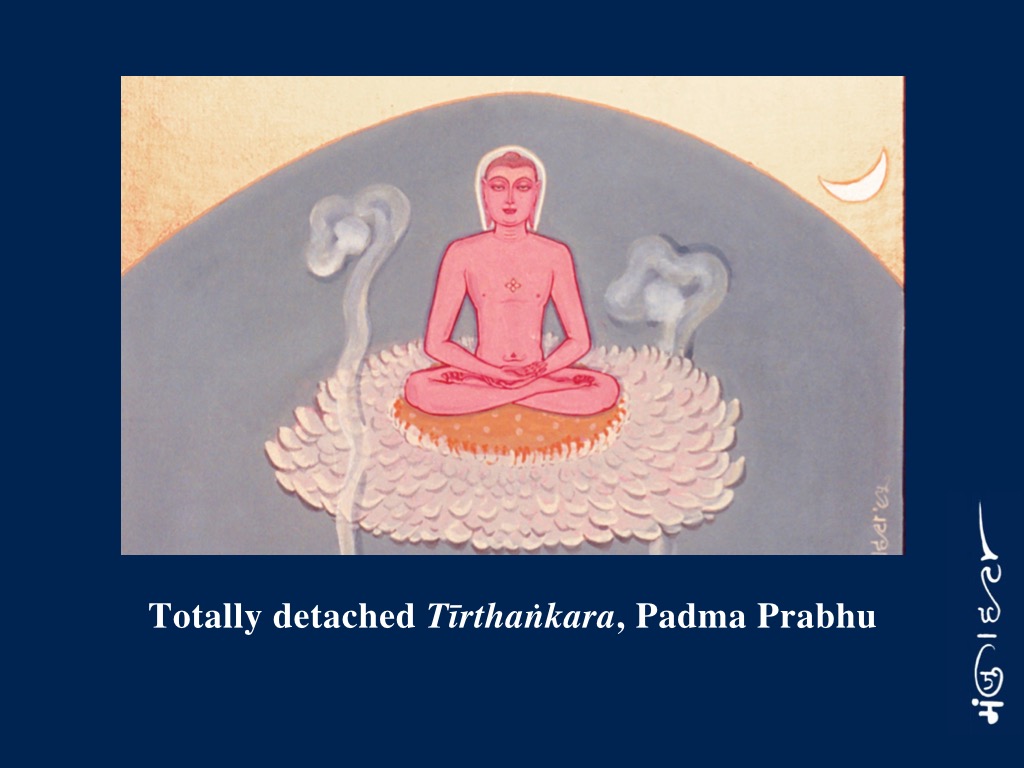
In accordance with Stella Kramrisch, Indian artists have reached to the climax of likeness and have shown gods in the idols and paintings, as if they are breathing. In the center of the painting, tīrthaṅkara Padma Prabhu, is shown sitting on the lotus (the lotus itself being symbolical of him); he is shown in a state of meditation with his eyes open (symbolising detachment), living in the world but still away from it as he is totally detached from all worldly desires. In Samayasāra it is described that:
ṇāṇī rāgappajaho savvadavvesu kammamajjhagad
ṇo lippadi rajaeṇa du kaddamamajjhe jahākaṇayam
A piece of the iron kept in the mud gets rusted, but the gold will stay unaffected even as it is kept in the same place. Those, who are completely detached from all worldly passions, even if they carry out a biological existence in the world like arihanta, are blessed with a supreme knowledge about life. They are therefore unaffected by ghātī karmas; whereas those who are attached to all varieties of worldly passions are bound to be affected by both the ghātī karmas (i.e. the karmas which destroy virtues of the soul) and the aghātī karmas.
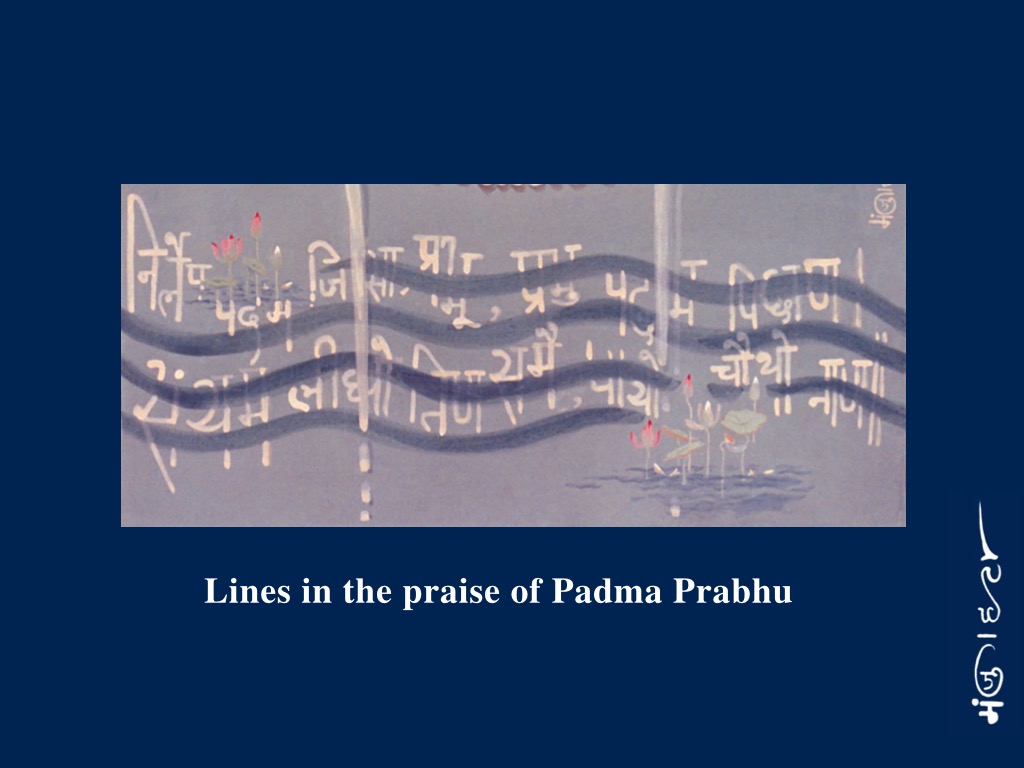
Lines in Padma Prabhu's praise have been written in a wavelike pattern under the belief that water has an enriching influence over the devotees.
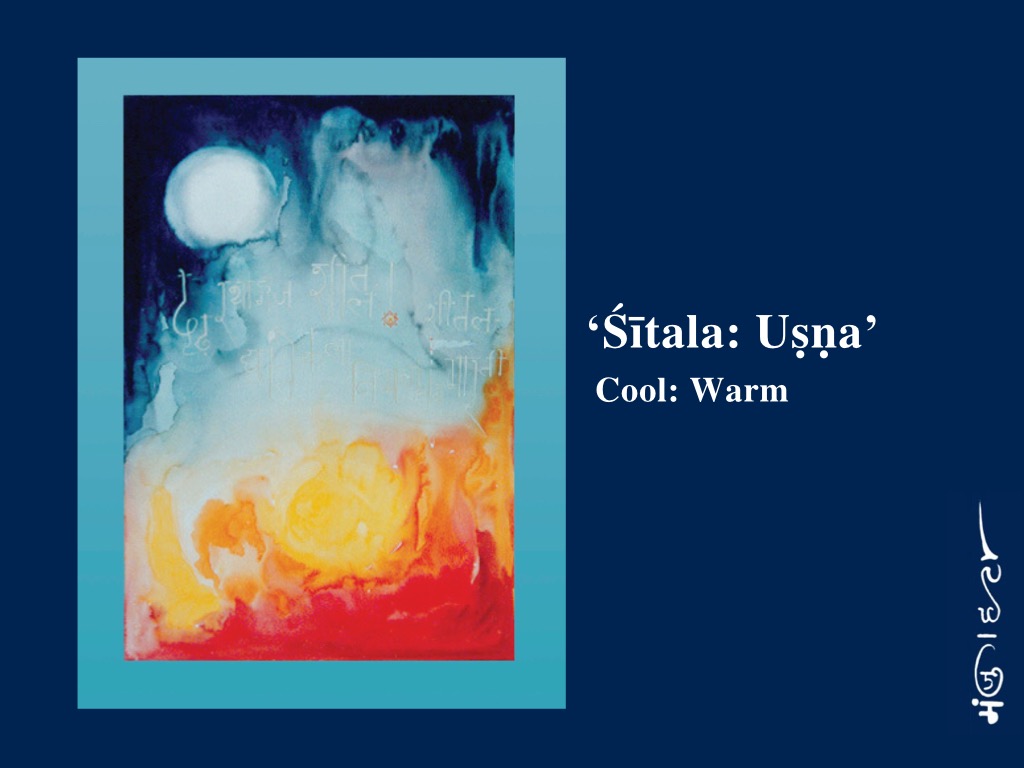
Lord Śītala was imbued with virtues true to his name. Once his father King Driḍha Ratha was taken ill with bilous allergy. In spite of medical treatment the disease did not subside. Miraculously, just the touch of the pregnant queen Nandā (with Śītala Prabhu in her womb), resulted in a complete cure of the disease.
Lord Śītala radiates, as the moon does, the soothing cool light; he also imparts knowledge, jñāna, the way the sun spreads its beams. The same source generates heat of the sun and coolness of the moon. There is no such existence in the world, which does not have its contrary existence as well.
The matter has been treated here from a painter's point of view. Here both the sun and the moon are shown as having individual qualities of coolness and brightness, though through these individual qualities a sense of coexistence is highlighted.
The painting, which is in water-colour shows the contrary nature of 'coolness' projected from the moon-beams and 'brightness' as radiated from the sunrays. Care has been taken to lead the viewer out of the literalness of the painting to its metaphorical significance with reference to Lord Śītala. One might question why I have not shown Lord Śītala in the painting, but the purpose of the painting is to highlight what he stands for rather than how. By no means, his inhering the essential opposition - coolness redolent of his name and brightness redolent of his knowledge comparable to sunlight - can be far away from anekāntavāda.

Here in this painting centre and circumference two contradictory things have been shown and it is obvious that one can never meet the other. But the circumference, though different from the centre, owes its existence to the centre, whereas centre without a circumference is merely a dot. Here the goal inheres all twenty-four tirthankaras and it is painted in the centre. The effort, in this case shown as japa or chanting required to reach the goal is shown on the circumference. The painting seemingly resembles a yantra.
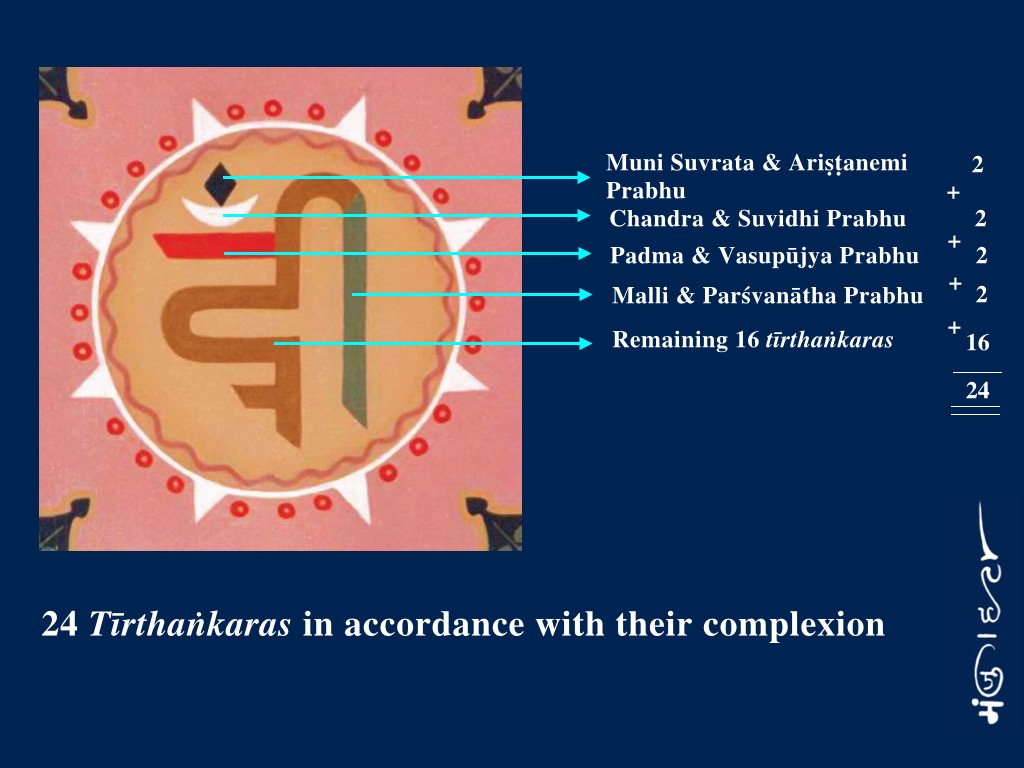
A genital mantra, 'Hrim' is painted in the centre and the centre consists of twenty-four Tīrthaṅkaras strictly in accordance with their respectiv
Two Tirthaṅkaras in black colour - Muni Suvrata and Ariṣṭanemi Prabhu.
Two Tirthaṅkaras in white colour - Chandra and Suvidhi Prabhu.
Two Tirthaṅkaras in red colour - Padma and Vasupūjya Prabhu.
Two Tirthaṅkaras in green colour - Malli and Parśvanātha Prabhu.
And the rest sixteen tīrthañkaras are in gold colour.
There is a winding line with twenty-four waves touching the inside edge of the white circle and this line symbolises twenty-four tīrthaṅkara. This wavy line shows their internal realisation as well as their various states, as between perception and intuition, for instance. At the outer part of the white circle, again, there are twenty-four red circlets, which stand for twenty-four tirthaṅkaras. Eight bright white arrow points, attached to the white circle, show eight directions in a way the tirthaṅkaras show us the right directions in our life.
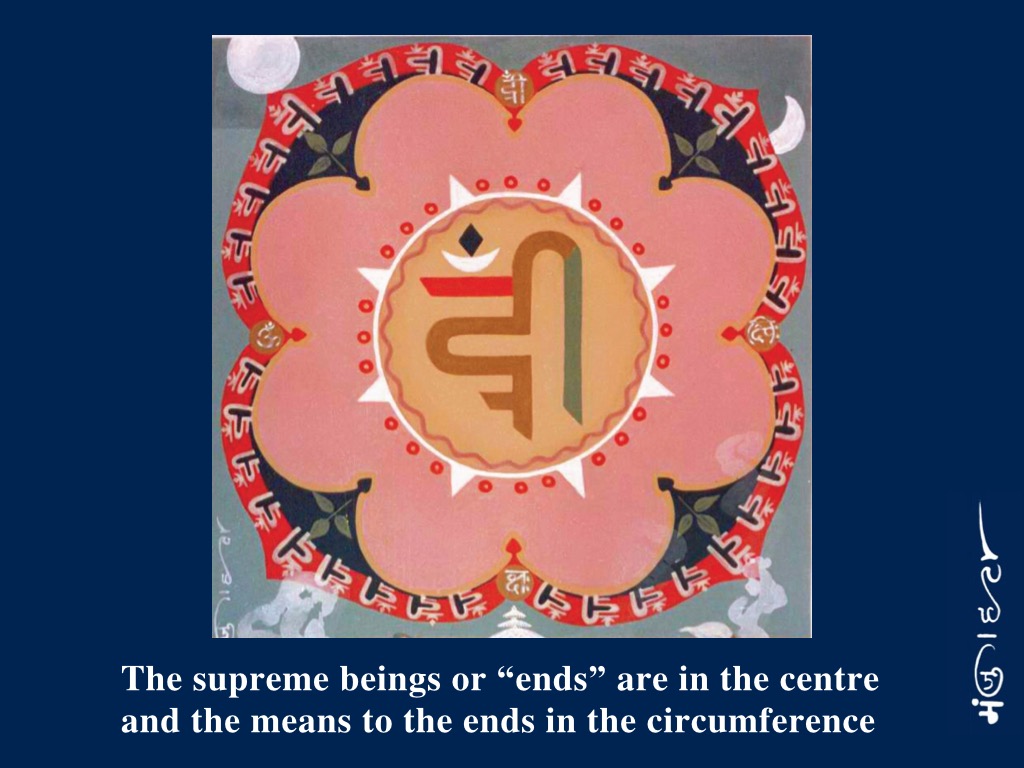
In the centre of the painting, a big lotus has been drawn in pink, in resemblance to the complexion of Lord Vasupūjya. At the outermost part of the big pink lotus, in four directions, 'Hrim' mantra is written in three colours - red, blue and white, the colours respectively showing origination, cessation and continuation (mātrkāpada). There are four more genital mantras drawn in four directions of the lotus painted and the mantras are painted in ochre. These are- 'Hrim\ 'Ksvih', 'Ksah', 'Om'. In this painting, the sun and the moon, drawn in white colour, stand respectively for the soul and the mind. A person, if he\she feels being pulled to gravitate, from the circumference to the centre, of course supported by soul and mind, is bound to reach the goal. The supreme beings (the ends) are shown in the centre and the means to the ends are shown in the circumference. Here, I have taken recourse to the ' japas' as one of the means.
I have chosen Lord Vasupūjya for this painting because, as he is the twelfth tīrthañkara, he is in the centre of the twenty-four tīrthañkaras. Lines in his praise appear at the bottom.
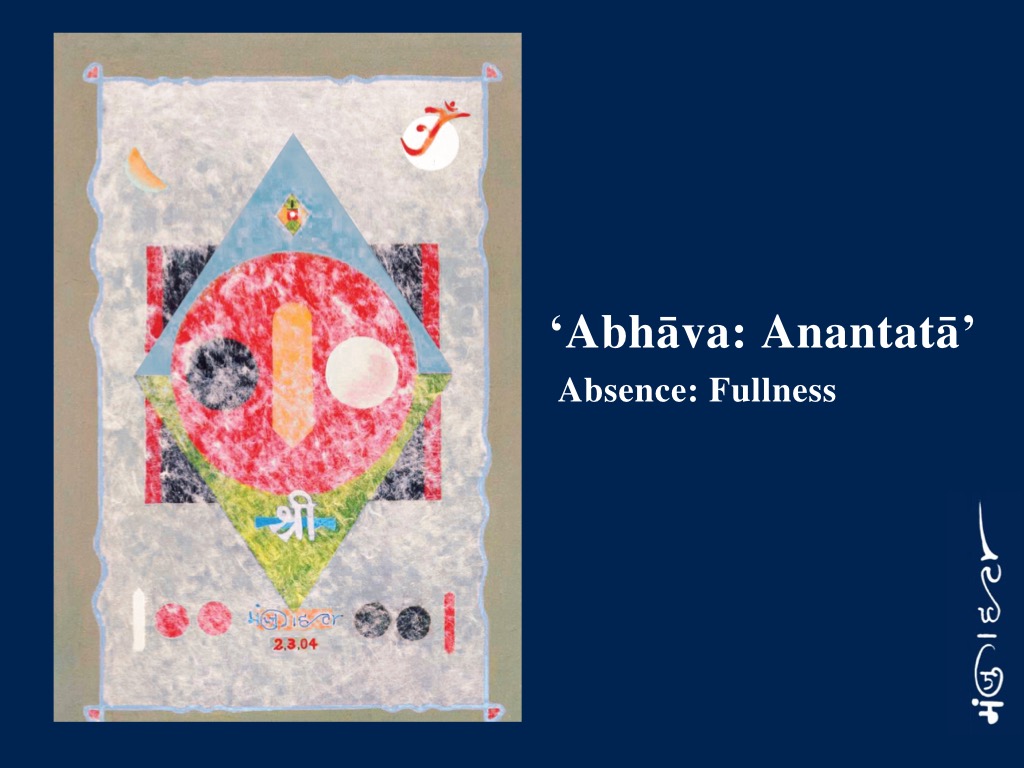
Now just for a change, if I move to Mathematics we will find ample traces of this philosophy. We all are aware of the fact that Mathematics of this world owes its existence to the discovery of zero. For the purpose of calculation, it needed a short symbol and at present it is denoted by a small circle in nearly every part of the world. In India in the early period, the form of short symbol, which represented zero (śunya) was both a small circle and a dot.
Here, in my painting, I have presented zero as a dot in both big and small sizes. In accordance with Jain philosophy, the soul is the minutest of minute and the greatest of great. Similarly, śunya or zero itself signifies absence when placed independently, but it represents fullness when it is placed in decimal system of numeration. Placing of zeroes on the right hand side of a number increases the value to an infinite step.
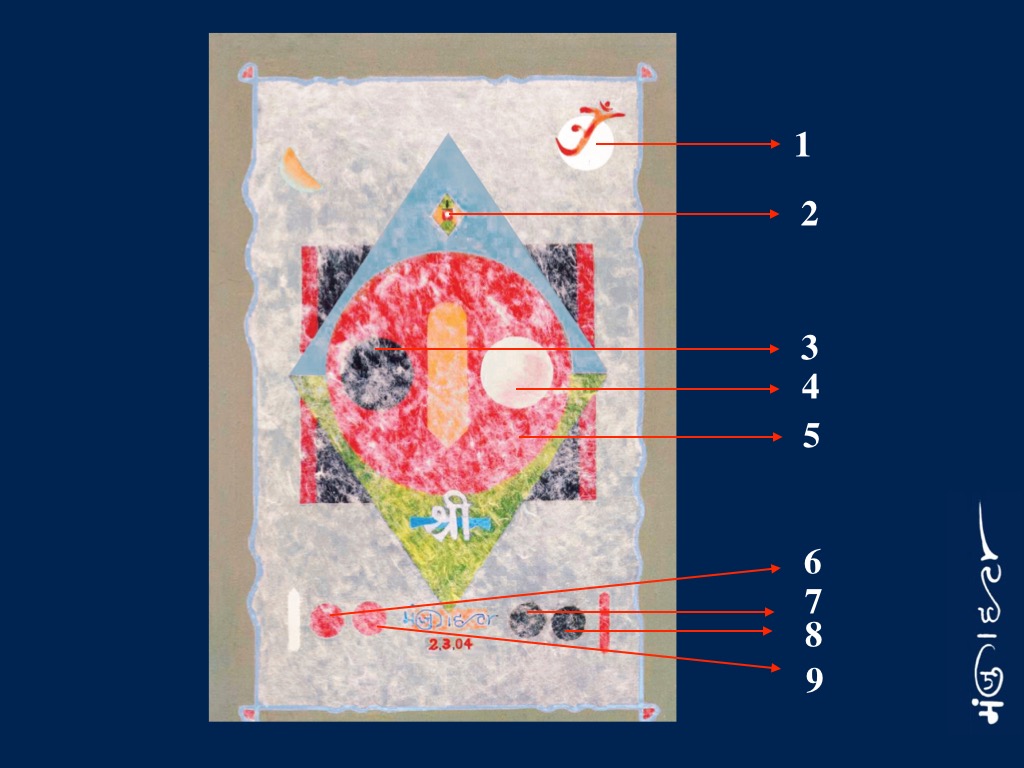
The double interpretations of mathematical zero, the absence and the fullness, are observed in a planet. Planet is a combination of atoms. It shows that one of the largest things is made of smallest possible particles called atom. Here, in this painting nine zeroes, each shown in different sizes and colours, symbolise nine Grahas.
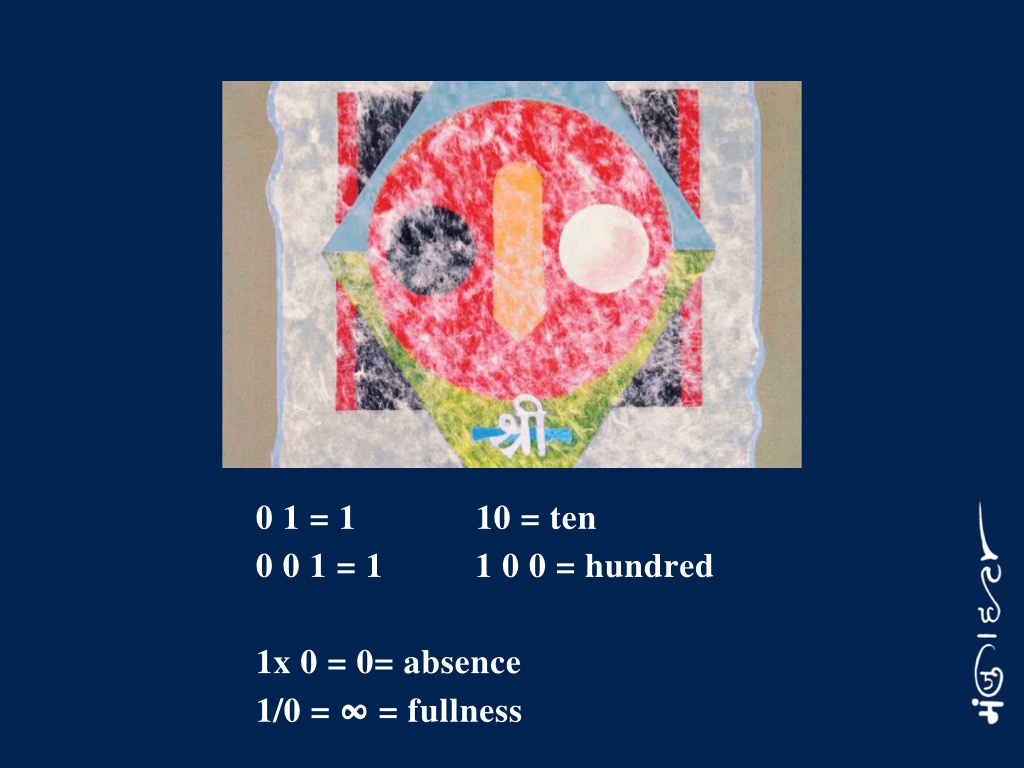
Zero as such has an absolute value equivalent to what it actually is by itself. The absolute value is neither positive nor negative. One zero or many zeroes taken together have one and the same value, i.e. zero. Zero when placed on left hand side of a digit is insignificant, but at the same time taken on the right hand side of the same digit has a significant value.
This is clearly shown in the centre and the nether part of my painting. The treatment in the painting of the concept of zero, keeping in view the non-absolutism, is such that gives an impression of nothingness as well as of fullness. Existence of zero on the right hand side of a digit is an affirmation of zero and on the left hand side is the negation of zero. In the same way, the intrinsic nature of the substance is the source of existence, while the extrinsic nature of a substance is the source of non-existence.
Multiplication and division are two opposite operations of Mathematics. Any number multiplied or divided by zero gives two extreme values - zero (absence) and infinity.
The small Śri-Vatsa which is painted in a light blue triangle depicts the sky. Ergo, we come, to the conclusion that zero is a quantity, and also the total absence of quantity, considered as a quantity. Zero does not mean anything if it precedes a numerical but the same zero makes the value of the numerical ten-fold, if it follows the numerical.
 Dr. Manju Nahata
Dr. Manju Nahata